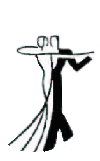 |
ROUND DANCING — CHOREOGRAPHED BALLROOMEDUCATIONAL ARTICLESMAJOR SECTIONS: Figures | Articles | Links | Alph. Index | Search | Home |
|
|
CHANGING WALKING INTO DANCING -- SIDE LEADby Harold & Meredith Sears When we walk, we face our destination squarely, but dancing looks better if we use side lead or body orientation on the diagonal. Rather than directly facing or backing the line of progression, try angling or slicing down the hall with one or the other shoulder leading the way. Instead of dancing forward with your belly button pointing where you're going, turn a bit so your left side precedes your right and your belly button points diagonally toward wall. I think of a barge plowing forward, directly into the wind and current, "breasting" the waves, forcing its way forward. Dancers don't want to "bull" their way along. Better to progress at a graceful angle, slipping smoothly through the music, with one or the other side leading. When you step with one foot and lead with that same side, it is simply called side or shoulder lead. You might begin a foxtrot Three Step with the left foot and with a little left side lead. Side lead is especially helpful in dancing and leading a locking action. Begin a Forward Lock Forward with the left foot and strong left side lead, and your trail foot will lock behind much more comfortably than if you have no side lead. Furthermore, your lady simply won't be able to lock in front without the side lead. Do a Natural Turn, Spin Turn, and Right Turning Lock. Only if you lead strongly with your right side in this last figure will you be able to lock comfortably, you in front and your partner behind, as you turn right-face.When you step with one foot and lead with the opposite side, it is called contra body movement (CBM). CBM is a turning or twisting of the body toward the moving foot. The slightly twisted (contrary) position that results is called contra body movement position (CBMP). CBMP occurs whenever a step is taken across the body, whether or not the body turns. For instance, in semi-closed position, a step through with the trail foot produces CBMP. The man's body is facing diagonal line and wall and his step is down line, "across his body." This step produces CBMP even though the body has not turned during the step. Let's go back to our Right Turning Lock and follow it with a Feather. We will step forward with the right foot and with left side lead. Here, contra action helps you keep your hips to your partner's as you move outside your partner into banjo position. Put yourselves into closed position facing reverse, and do a Back Feather. Step back left with right side lead. Contra action involves stepping across your line of progression: in the forward Feather, the man steps forward right, crossing thighs, right in front of left, and in the Back Feather, he steps back left, again crossing thighs, left in back of right. CBM is also used to begin most turns, and a good way to think about CBM is to think of turning toward the moving foot. Start a natural turn by stepping forward with the right foot and use left side lead to begin the turning movement to the right. It is important to turn the body at the same time as you take your step — do not step and then turn the body as an afterthought. Start a reverse turn with the left foot and right side lead. Or think about swinging the contra side forward: as you step forward with the left, swing the right hip and shoulder forward. Be natural and fluid in this movement. Don't jerk or contort your body. Don't let the contra body action affect the direction of the footwork. Just as dancing looks better if your progression is along curves and diagonals, rather than down straight lines, so does it look more graceful if your body is gently angled.
A version of this article appeared as “Icing On the Cake” in the Dixie Round Dance Council (DRDC) Newsletter, March, 2005.
If you would like to read other articles on dance position, technique, styling, and specific dance rhythms, you may visit the article TOC. Past DRDC Educational Articles archived here. Go beyond this site. Find other references on our Sources and Links pages.
|
 |
|
|